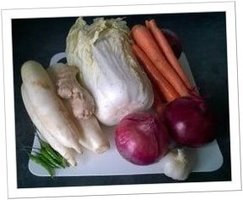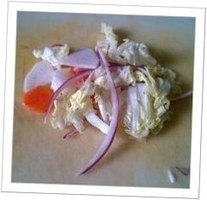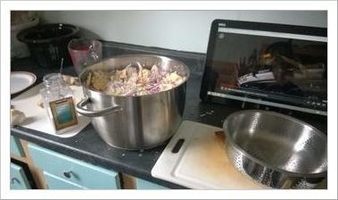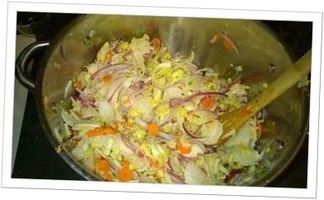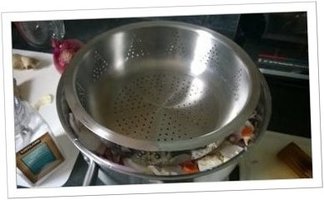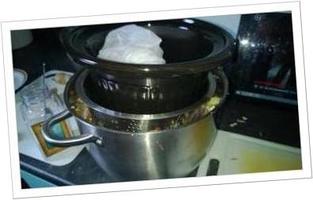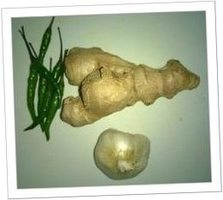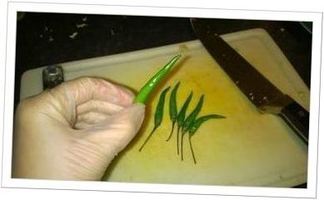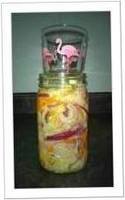How to Make Kimchi
 January 16, 2015
by
Leslie Anderson
January 16, 2015
by
Leslie Anderson
I’m not going to get into the whys of making kimchi. It’s tasty, it’s healthy, it’s cheap, it doesn’t go bad, and an hour of your time can feed you for weeks. Those are all qualities an author should be able to appreciate.
Ingredients:
-
2 pounds of nappa cabbage, chopped
-
1-2 daikon radish, sliced thin
-
2-4 carrots, sliced
-
1 onion (yellow or red), sliced
-
2-5 cloves garlic, minced or pressed
-
1 tablespoon or more grated garlic
-
Hot peppers (Optional, though I recommend. I use 2-3 seeded Thai chili peppers.)
-
4 tablespoons (or more) sea salt
- 4 cups (or more) water, preferably non-chlorinated.
Time required:
-
Active: 1-2 hours (depending on how good at chopping you are.)
- Inactive: 1-2 weeks (depending on how warm your house is.)
Prepare the nappa cabbage, daikon, carrots, and onions.
Put them in a large pot or bowl and mix them up. Combine the salt and water, making sure the salt is largely dissolved. Pour the salt water over the vegetables, and weigh down the vegetables so that they are covered with the water. The vegetables will crunch down a little bit, so initially they might not be covered. If you think you need more salt water to properly cover the vegetables, add more.
Let them soak in the salt water for at least two hours. I prefer longer than that.
While soaking, you can prepare the garlic, ginger, and peppers.
Drain the vegetables, reserving some of the liquid. A few cups should be plenty.
Taste the vegetables. They should taste salty, but not unpleasantly so. If they’re way too salty, soak them in normal water for a few minutes and drain.
Mix together the vegetables with the garlic, ginger, and peppers. Be sure to mix well.
Pack tightly into … something. I primarily use a rock-sugar jar from Teavana. It’s the perfect size. Unless you have need of a lot of German rock sugar, I suggest using mason jars or crocks. (I’ve used both.)
If you’re in the US, you can mostly likely get mason jars from your local hardware store (I hit up the True Value near me). If you have a crockpot, you can use the crock from that. If you don’t (or can’t spare your crock for a week or two), you can often buy standalone crocks from thrift stores for really cheap.
You want to pack the vegetables into whatever container you choose as tight as you can, then put some sort of weight on the top to ensure that the liquid level is above the vegetables.
-
If fermenting in a jar, often times all you need is a glass.
-
If fermenting in a crock, you’ll likely need something bigger and heavier. Like, a plate of the perfect diameter, a Tupperware to sit atop the jar, and something heavy to go in that Tupperware to weigh everything down.
- If you can’t seem to weigh it down enough for the liquid in the vegetables to cover everything, you can add some of the reserved soaking liquid.
Set it off to the side somewhere that it won’t get too cold. Cover with a tea towel to make sure that bugs can’t get in. Then just let it sit for a week or two. You can taste it daily to see how it progresses and determine what level of fermenting you prefer. Just make sure the liquid level is above the vegetables. Depending on how long you soaked your vegetables, you may have air pockets develop in the vegetables. Stirring every day or so will allow this air to escape, which keep your veggies fermenting properly.
I serve kimchi with short-grain rice, hardboiled eggs, toasted seaweed, and toasted sesame seeds. That means that if I’m in the middle of a crazy deadline I can just throw rice in the rice cooker, eggs on to boil, and I can have a healthy, tasty meal with little time spent.
Not to mention, it’s cheap! That pot in the picture is an 11 quart pot. That makes a ton of kimchi.
I recommend shopping at your local Asian market to find similar prices. I can get daikon and nappa cabbage from high-end supermarkets, but for double or triple the cost of them at the Asian market.
Cost for my most recent batch:
-
Nappa Cabbage (1): $2.88
-
Red Onions (2): $2.61
- Daikon radish (3): $2.71
It’s a little bit harder to calculate the carrots, ginger, and garlic as I buy them in bulk. Also, a bag of the peppers costs somewhere around $1.50 for around 40 peppers, and I’m too lazy to calculate how much each pepper costs. Let’s pretend that it costs about $3.00 across the board. That’s including sea salt and the use of the RO water. If anything, I think that’s overestimating.
That leaves us with a total of: $11.20. For four quarts of kimchi. Each quart lasts us about a week, at one meal per day. That’s $1.40 dollars per person per week. Or $0.20 per meal. Add in the eggs, rice, seaweed, and sesame seeds, and you’ve still got a cheap meal.
